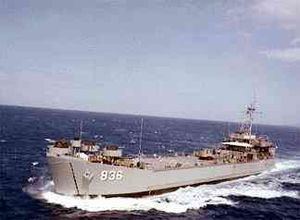Name USS LST-836 Commissioned 25 November 1944 Recommissioned 3 November 1950 Launched 29 October 1944 | Laid down 11 September 1944 Decommissioned 25 July 1946 Construction started 11 September 1944 Length 100 m | |
 | ||
Builder American Bridge Company, Ambridge, Pennsylvania | ||
USS Holmes County (LST-836) was an LST-542-class tank landing ship built for the United States Navy during World War II. Named after counties in Florida, Mississippi, and Ohio, she was the only U.S. Naval vessel to bear the name.
Contents
- World War II 19441946
- Korea 19501954
- Pacific Fleet 19541964
- Vietnam 19651971
- Decommissioning and sale
- References
Originally laid down as LST-836 by the American Bridge Company of Ambridge, Pennsylvania on 11 September 1944; launched on 29 October; sponsored by Mrs. H. E. Hetu; and commissioned on 25 November with Ensign Elmo J. Sullivan in command.
World War II, 1944–1946
After shakedown off Florida, LST-836 loaded ammunition, lumber, and cement, then departed New Orleans on 2 January 1945. She unloaded the cargo at Balboa, Panama in the Canal Zone, and proceeded to San Diego, arriving on the 23rd. In early February she sailed for Hawaii, where she trained, embarked troops, then steamed to the Marshall Islands. Following three weeks of preparation in the Marshalls and Carolines, the landing ship departed Ulithi on 12 April for Okinawa. With the battle for this strategic base well underway, LST-836 arrived six days later; unloaded troops and equipment and returned Ulithi on 29 April. For the rest of the war, she shuttled cargo and troops throughout the Pacific; then after VJ Day was assigned to duty with the occupation forces in Japan. Returning to the United States LST-836 arrived San Francisco on 19 January 1946; and remained on the West Coast until she decommissioned at Vancouver, Washington on 25 July 1946.
Korea, 1950–1954
Following four years in the Pacific Reserve Fleet, LST-836 recommissioned at Bremerton, Washington on 3 November 1950 with Lieutenant Thomas J. McLaughlin in command. After refresher training she sailed for the Far East, to join United Nations forces in South Korea. Arriving Yokosuka on 28 March 1951, the veteran landing ship was once again assigned to a battle zone and for the next eight months shuttled cargo and troops between Japan and various Korean ports. After a brief stateside overhaul in early 1952, LST-836 departed San Diego on 24 July for operations in conjunction with the first hydrogen bomb tests in the Marshall Islands. From August to November she aided scientists as they tested this new source of power. She returned to San Diego; then, after a brief respite, sailed on 16 March 1953 for further duty in the still raging Korean War. Arriving at Yokosuka on 22 April, LST-836 immediately commenced cargo runs from the staging areas to Inchon. When the fighting ended, LST-836 remained in the Far East to transport cargo to the United Nations peacekeeping force stationed in Korea.
Pacific Fleet, 1954–1964
From 1954 to 1959 she made three WestPac cruises and participated in training operations along the West Coast. On 1 July 1955 LST-836 was renamed USS Holmes County (LST-836). Following a FRAM overhaul in late 1959, the landing ship was assigned to the Pacific Amphibious Force, and for the next five years Holmes County engaged in amphibious exercises along the West Coast and in the Hawaiian Islands.
Vietnam, 1965–1971
On 11 October 1965 Holmes County left San Diego for operations in Southeast Asia. She arrived at Da Nang, South Vietnam on 22 November and operated there for the rest of the year and into 1966. On 29 March 1966, after 89 days in the combat zone, Holmes County steamed for Yokosuka, Japan, for upkeep before starting the 5,500-mile journey home. Holmes County received the following message from Commander 7th Fleet: "As you depart 7th Fleet Intra-Coastal Task Unit, be assured you leave behind an admiration for the extraordinary work you have done this cruise." On 26 May Holmes County arrived home. After serving in the San Diego area for four months, she participated in the Fleet Exercise "Operation Base Line" in October. This was one of the largest peacetime operations conducted by the Pacific Fleet.
Holmes County later returned to Vietnam, operating in that theatre until at least 1970.
Decommissioning and sale
Holmes County was transferred on loan to the Republic of Singapore Navy (RSN) on 1 July 1971, being renamed RSS Endurance (L201). The ship was sold outright to Singapore on 5 December 1975. Endurance, along with other ex-US LSTs served as part of 191 Squadron of the 3rd Flotilla, with the main roles of transporting Singapore Army personnel to overseas training facilities and for cadet training. Endurance was re-engined with MTU diesels during her service with Singapore.
Following the commissioning of the new RSS Endurance (LS207) into the Singapore Navy in 1999, she was decommissioned for the last time that same year along with her sister ships Excellence (L202, ex LST-629), Intrepid (L203, ex LST-579) and Persistence (L205, ex LST-613). Currently, all four are used as floating defense barricade for Changi Naval Base.
LST-836 received one battle star for World War II service, three stars for the Korean War, and 11 campaign stars for her service in Vietnam.
